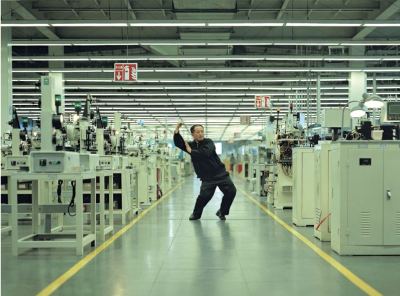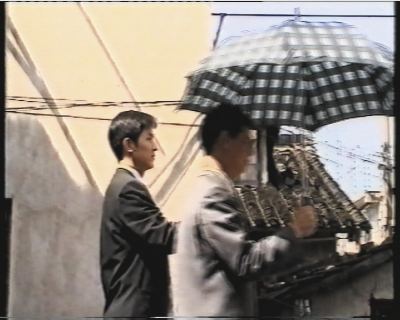 In a good economy with a sold middle class, factory work seems dreary. Is this all there is? What about my hopes and dreams? In a bad economy with an eroded middle class, whatever factory work remains is an enviable a safe haven. As Bob Dylan put it in Tangled Up in Blue, “lucky just to be employed.”
In a good economy with a sold middle class, factory work seems dreary. Is this all there is? What about my hopes and dreams? In a bad economy with an eroded middle class, whatever factory work remains is an enviable a safe haven. As Bob Dylan put it in Tangled Up in Blue, “lucky just to be employed.”
Cao Fei’s My Future Is Not A Dream has a human-clog-in-the-machine feeling without the usual rage or desperation, because in this video, each clog is conscious of his/her contribution. Then there’s the magic: A ballerina appears en pointe as a dying swan and, in the next scene, as a sorter of light bulbs. A man with a clip board takes up the dance, and so does a women in jeans.
My Future Is Not A Dream is not the alienated surreal of Doug Aitken or the worker advocacy of Allan Sekula. It is a homage to those who make things with their hands and dream with their hearts, in Mark Twain’s words, those “valuable personages; the
workers, they that make the bread the soft-handed and ide eat.”
As Jacob Lawrence said about his Builders series:
There is always an effort to express the universal beauty
of man’s continuous struggle to lift his social position and to add
dimension to his spiritual being.
Yang Fudong’s City Lights is a madcap improvisation of the classy noir mood of French gangster films.
 Men in dark suits peer around the edge of buildings, guns raised. They hold umbrellas and dance in office buildings in the shaded light of venetian blinds. Some hold guns, umbrellas and partners, others pretend the props are in their hands, that they’re not alone and ridiculous.
Men in dark suits peer around the edge of buildings, guns raised. They hold umbrellas and dance in office buildings in the shaded light of venetian blinds. Some hold guns, umbrellas and partners, others pretend the props are in their hands, that they’re not alone and ridiculous.
Multiple short films by Cao Fei and Yang Fudong are at the Henry through Oct. 4.



I like how Jasper Johns’ show of lightbulbs prints downstairs and the video about lightbulb manufacture is upstairs. Let their be light.
I don’t get the Henry. I walk in there and I’m at sea, and I like contemporary art. You’ve written more in these short summaries than the museum ever offers. It feels to me like an insider’s club. If you’re in the know, swell. If you’re not, nobody’s going to help you.
It almost seems as though you did not see either film entirely, or recognize their significance to the change in China’s culture. The dancing like a dying bird is the loss of their dreams. At the end the workers look either uncomfortable or worse, have no expression at all like they had lost their “souls”. Fudong is portraying social change in China and the tension and stress it causes.
In every culture, a dying bird is a symbol of an end, at the very least, the bird’s end. This film has more. It makes and unmakes that meaning.